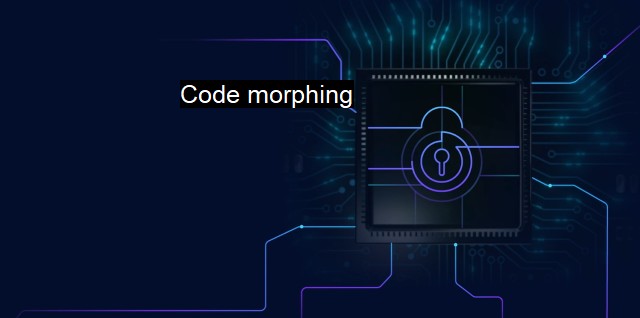What is Code morphing?
Stay One Step Ahead: Secure Digital Assets with Cutting-Edge Code Morphing Technology in Cybersecurity
Code morphing refers to a fascinating defensive mechanism whereby a computer program or malware's source code continuously changes while the functionality remains unaffected. This cunning trick is engineered to evade antivirus security systems that rely upon the uniqueness of code to identify and quarantine malicious software applications.Code morphing is a manifestation of polymorphism, a concept in programming that has various interpretations depending on context. polymorphism refers to malware that self-alterates, reshaping its code over time to evade detection while its function remains the same. code morphing techniques aren't solely used by attackers; it's also employed by those who stand guard over the walls of cybersecurity and endeavor to thwart attacks.
Antivirus programmers have had to adapt their detection techniques as the nature of threats has evolved. Initially, most malware was detected by examining its characteristics – similar to identifying a criminal based on their features. If a piece of software had particular traits that equated to a 'known bad' then anti-viruses would flag it as such. as malware began adapting and morphing through techniques such as code morphing, felony detection based purely on characteristics became less valuable.
To effectively respond to code morphing, cybersecurity operatives now leverage more evolved response mechanisms. Heuristic analysis examines the behavior of a program or executable and if it performs an activity that matches a list of 'unusual behaviors', it raises the red flag. In emulation, the security system anticipates the malware longer in virus sandboxing, with zealous scrutiny and close observance even after permeation.
Code morphing, as useful as it has become in protecting and penetrating systems, also has several disadvantages. Since it scrambles and rewrites code to appear differently, good programming can occasionally be classified as suspicious due to its distinction, triggering false positives. Sometimes, purely innocent programs get flagged, creating a tangle of confusion for the cybersecurity team.
Usually, code morphing in a contagious virus cause larger files, impelling it to consume ample memory and swell its footprint. Greater the variety in the virus’s iterations, substantial the capacity it requires. Not only does this technique drain resources, but it also offers investigators with analogous copies of attacks to investigate on, unintentionally creating breadcrumb trails that lead back to the source of weaponry.
Speaking in a more technically nuanced sense, there are numerous methodological stratagems for activating the code morphing, via encryption, metamorphism or file integration. Meta-morphism involves recompiling replicated malware from a compiler engine integrated within the malware. encryption treats the malware as a cipher that can be unlocked and deployed via a key released by the encrypted virus; once unlocked, the virus rearranges its encryption for the next cycle.
Code morphing presents an inventive yet double-edged sword for cyber warfare. Its strength lies in its capability to replicate persistently while evading detection measures. it ends up amplifying the size of files, hardware resources, and consequently leading investigators to original malware.
This ghost-like morphing elucidates that modern cybersecurity isn't just about erecting barriers; it's about staying rapidly adaptable. In a world where software can metamorphosize faster than defenses can be updated, the future of antivirus doesn't just involve finding better walls; it’s about inventing smarter hunters that can track these malicious code ghosts across their transformative journeys, matching step for carpentered step, cathedral for scrambled paragraph. Whether the tactics are legal or otherwise, one rudimentary fact rings evident – code morphing enables one to stay a malware app ahead in the game, contributing both defense and attacks on the chessboard of digital security.

Code morphing FAQs
What is code morphing?
Code morphing is a cybersecurity technique that involves dynamically changing the code of an application or software to prevent it from being detected by antivirus or other security measures. It is often used by malware creators to evade detection and infect systems.How does code morphing work against antivirus?
Code morphing constantly modifies the structure and behavior of the malware, making it difficult for antivirus software to identify it through traditional signature-based detection. The malware can also encrypt itself to avoid being detected by antivirus software.What are the risks associated with code morphing?
Code morphing can make it difficult for antivirus software to detect and eliminate malware, which can lead to greater damage to systems and data. Additionally, code morphing can slow down systems and degrade their performance, as the malware is constantly modifying itself to evade detection.How can organizations protect themselves from code morphing malware?
Organizations can protect themselves from code morphing malware by implementing multiple layers of defense, such as using behavior-based detection, network-based detection, and threat intelligence. It is also important to regularly update antivirus software and ensure that all software and systems are up-to-date with the latest security patches.| | A | | | B | | | C | | | D | | | E | | | F | | | G | | | H | | | I | | | J | | | K | | | L | | | M | |
| | N | | | O | | | P | | | Q | | | R | | | S | | | T | | | U | | | V | | | W | | | X | | | Y | | | Z | |
| | 1 | | | 2 | | | 3 | | | 4 | | | 7 | | | 8 | | |||||||